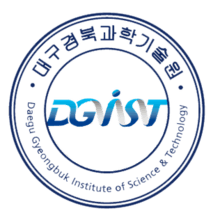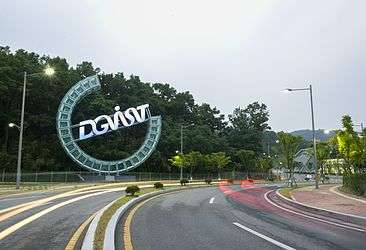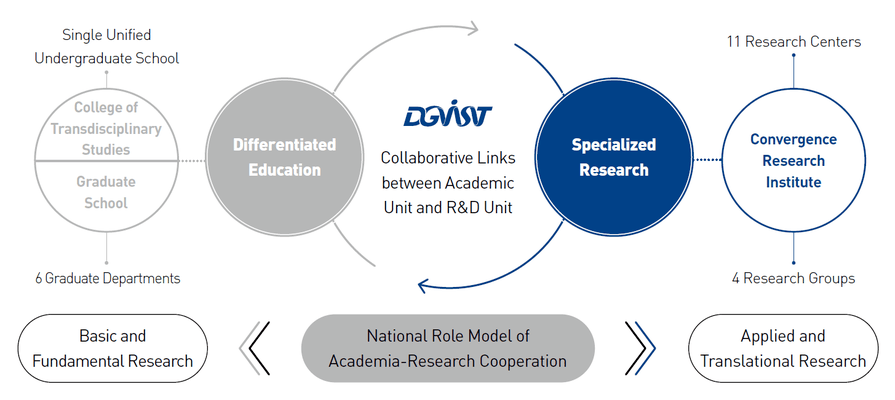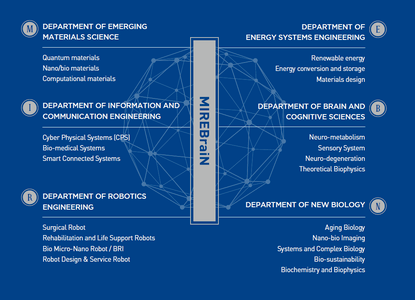Daegu Gyeongbuk Institute of Science and Technology
|
대구경북과학기술원 | |
 | |
| Type | Public |
|---|---|
| Established | September 7, 2004 |
| President | Sang Hyuk Son |
Academic staff | 176 faculty (2017) |
Administrative staff | 179 (2017) |
| Undergraduates | 759 (2017) |
| Postgraduates | 482 (2017) |
| Address |
333, Techno Jungang-daero, Hyeonpung-myeon, Dalseong-gun, Daegu, Republic of Korea |
| Campus |
Urban 674,101 square metres (166.57 acres) |
| Colors | Blue and Gray |
| Website |
en |
Daegu Gyeongbuk Institute of Science and Technology (DGIST) (In Korean 대구경북과학기술원) is a public science and engineering university located in Daegu Metropolitan City, Republic of Korea. Under a Special Act on Support of Scientists and Engineers for Strengthening National Science and Technology Competitiveness, the Korean government enacted Daegu Gyeongbuk Institute of Science and Technology Act (Act No. 6996) and founded DGIST in 2004 as a research institute. In 2008, the act was amended to extend the role of the institute to both research and education, which eventually enabled a transition from a research institute to a university. The university is one among four Institutes of Science and Technology in South Korea which demonstrate a leading role in advancement of science and technology. DGIST has been growing as a leading university of science and engineering with its aim to facilitate national advancement by nurturing talented individuals through its innovative convergence education and research.
History
In 2004, the Korean Government established DGIST as a research institute to promote national science and technology, and located the institute in Daegu to invigorate the local economy. The government amended DGIST Act in 2008, enabling the institute to offer its educational (degree) programs.
The first president of the institute, when it had a form as a research institute, was Kyu-Suk Chung, appointed in 2004; the second was In Seon Lee, appointed in 2007. The current president (as of April 2017), Dr. Sang Hyuk Son, took office as the third president of DGIST after Dr. Sung-Chul Shin, who was inaugurated as the founding president and served a consecutive term as the second president of the university from the year 2011 to 2016.

Dec 11, 2003 Enacted DGIST Act (Act No. 6996,) which implies its legal basis for the establishment of DGIST Sep 03, 2004 First President Kyu-Suk Chung was Inaugurated (research institute) Sep 07, 2004 Registered the Establishment of DGIST as a research institute Sep 03, 2007 Second President In-Seon Lee was Inaugurated (research institute) Jun 13, 2008 Amended the DGIST Act (Act No. 9108) to allow DGIST to offer its educational (degree) programs May 08, 2009 DGIST Vision & University Identity Proclamation Ceremony Nov 22, 2010 Moved Campus to Current Site, Hyeonpung Feb 25, 2011 Dr. Sung-Chul Shin was inaugurated as founding president of university Mar 02, 2011 First Matriculation Ceremony of the Graduate School was held Dec 14, 2011 Established the Korea Brain Research Institute (KBRI), affiliated institute of DGIST Mar 02, 2012 Second Matriculation Ceremony of the Graduate School May 02, 2012 Proclaimed VISION 2020 & Campus Ground-breaking Ceremony was held Jul 16, 2012 Established the DGIST-LBNL Joint Research Center Oct 08, 2012 Established the Center for Plant Aging-Research, Institute for Basic Science (IBS) Oct 30, 2012 Established the CPS Global Center Feb 15, 2013 First Commencement of the Graduate School was held Mar 04, 2013 Third Matriculation Ceremony of the Graduate School was held Feb 21, 2014 Second Commencement of the Graduate School was held Mar 03, 2014 First Matriculation Ceremony of the Undergraduate School was held Jun 13, 2014 Campus Dedication Ceremony was held Sep 16, 2014 DGIST 10th Anniversary Ceremony was held Feb 26, 2015 Dr. Sung-Chul Shin was inaugurated as the Second President of university Apr 01, 2015 Established DGIST Convergence Research Institute Apr 19, 2016 Established Core Protein Resources Center Oct 19, 2016 Established Well Aging Research Center Mar 22, 2017 Dr. Sang Hyuk Son was inaugurated as the third president of university
Organization and Administration
Win-Win Academia-Research Cooperation
Through a coexistence of its education and research institution, DGIST seeks convergence and cooperation between its academic unit--the university--and R&D unit--the DGIST Convergence Research Institute.


Academics
Undergraduate Program
School of Undergraduate Studies was opened in 2014 under the College of Transdisciplinary Studies. The School inspires young talents to enhance their sense of mission, vision and passion for themselves to be creative global leaders for the upcoming era, which will demand such scholars and leaders who can approach to complex problems with brilliant and convergencet solutions for the world.
- CLE Educational Principles: Convergence Education, Leadership Education, Entrepreneurship Education
- 3 Innovative Education Systems
- Transdisciplinary Curriculum within the Single Unified School: Students experience concentrated education in basic science and engineering for Years 1-3 and Track-customized education in the final years including the UGRP
- Solid Background in Basic Science and Engineering: Mathematics, Physics, Chemistry, Biology, Computer, Auto-control, Statistics
- Diversifying Knowledge with Humanities: Along with the focus on basic science education, the curriculum also emphasizes students’ humanities backgrounds through Oriental and Western philosophy, comparative history, art history, and physical education courses.
- Cultivating Creative Leadership
- Developing Sense of Entrepreneurship: It covers technology management and entrepreneurship.
- Teaching Faculty Dedicated to Undergraduate Education: All the professors in the undergraduate school are fully dedicated to undergraduate teaching, life mentoring, and research for the best quality of education.
- Faculty-developed Electronic Textbooks: E-books authored by faculty cover all undergraduate curriculum.
- Transdisciplinary Curriculum within the Single Unified School: Students experience concentrated education in basic science and engineering for Years 1-3 and Track-customized education in the final years including the UGRP
Graduate Program

The Graduate School has been offering Master's and Doctoral Degree Programs, including integrated MS-PhD programs. The idea of 'Convergence' is also well-reflected in designing graduate school curriculum. Based on the MIREBraiN program, which are DGIST's strategic areas on research and education, the graduate school offers its program in six majors since 2011.
- Department of Emerging Materials Science
- Quantum materials, nano/bio materials, computational materials
- Department of Information & Communication Engineering
- Cyber Physical Systems (CPS), bio-medical systems, smart connected systems
- Department of Robotics Engineering
- Surgical robot, rehabilitation and life support robots, bio micro-nano robot, BRI, robot design, service robots
- Department of Energy Systems Engineering
- Renewable energy, energy conversion and storage, materials design
- Department of Brain & Cognitive Sciences
- Neuro-metabolism, sensory system, neuro-degeneration, theoretical biophysics
- Department of New Biology
- Aging biology, nano-bio imaging, systems and complex biology, bio-sustainability, biochemistry and biophysics
Research
DGIST Convergence Research Institute
- Convergence Research Center for Solar Energy
- Convergence Research Center for Wellness
- DGIST-LBNL Research Center for Emerging Materials
- Research Center for Resilient Cyber Physical Systems
- Convergence Research Center for Microlaser Technology
- Convergence Research Center for Future Automotive Technology
- DGIST-ETH Microrobot Research Center
- Core Protein Resources Center
- Well Aging Research Center
- Convergence Research Center for Collaborative Robots
- Global Center for Bio-Convergence Spin System
- Companion Diagnostics and Medical Technology Research Group
- Smart Textile Convergence Research Group
- Magnet-Controlled Materials Research Group
- Intelligent Devices and Systems Research Group
Research Infra
In addition to the DGIST Convergence Research Institute, DGIST has state-of-the-art infrastructure to support and facilitate efficient research.
- Office of Research Administration
- Center for Core Research Facilities
- Supercomputing and Big Data Center
- Laboratory Animal Resource Center
- Office of Research Administration
- Office of University-Industry Cooperation
- Center for Technology Commercialization and Innovation
- Center for Technology Incubation and Development of Entrepreneurs
- Office of University-Industry Cooperation
People
The total number of members in DGIST was counted as 1,798 (as of March 2017). The number includes 1,241 of students enrolled for the 2017 school year (759 Undergraduates, 225 Master’s program students, 144 Ph.D. program students, and 113 Master’s and Doctorate Integrated Program students). Currently, 176 of faculty, 202 researchers, and 179 of administrative staffs are working at DGIST.
Notable Alumni
- Chan Sung Jung, professional Mixed Martial Artist, competing in the UFC's Featherweight Division[1]
References
- 1. Official website of the university: http://www.dgist.ac.kr
- 2. Article 'DGIST aims for spot among world-leading science universities': http://www.koreaherald.com/view.php?ud=20140924001064
External links
Coordinates: 35°42′19″N 128°27′26″E / 35.7053°N 128.4571°E